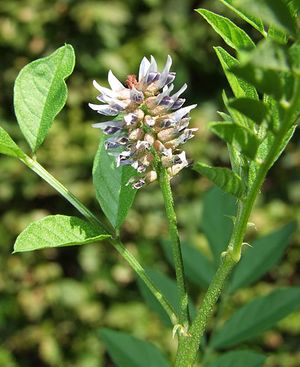Note: This is a project under development. The articles on this wiki are just being initiated and broadly incomplete. You can Help creating new pages.
Difference between revisions of "Glycyrrhiza glabra - Yashtimadhu"
Chaithrika (talk | contribs) (+Common names) |
Chaithrika (talk | contribs) (+adding content) |
||
| Line 8: | Line 8: | ||
The antiulcer, laxative, antidiabetic, anti-inflammatory, immunomodulatory, antitumour and expectorant properties of liquorice have been investigated. | The antiulcer, laxative, antidiabetic, anti-inflammatory, immunomodulatory, antitumour and expectorant properties of liquorice have been investigated. | ||
| + | |||
| + | ==Useful parts of the plant== | ||
| + | |||
| + | *'''Root'''. | ||
==Common name== | ==Common name== | ||
Revision as of 12:18, 21 March 2017
Liquorice, or licorice,[1] is the root of Glycyrrhiza glabra from which a sweet flavour can be extracted. The liquorice plant is a herbaceous perennial legume native to southern Europe and parts of Asia, such as India. It is not botanically related to anise, star anise, or fennel, which are sources of similar flavouring compounds.
Most liquorice is used as a flavouring agent for tobacco, particularly US blend cigarettes, to which liquorice lends a natural sweetness and a distinctive flavour and makes it easier to inhale the smoke by creating bronchodilators, which open up the lungs. Liquorice flavours are also used as candies or sweeteners, particularly in some European and Middle Eastern countries. Liquorice extracts have a number of medical uses, and they are also used in herbal and folk medications. Excessive consumption of liquorice (more than 2 mg/kg/day of pure glycyrrhizinic acid, a liquorice component) may result in adverse effects, and overconsumption should be suspected clinically in patients presenting with otherwise unexplained hypokalemia and muscle weakness.[2]
Glycyrrhizin has also demonstrated antiviral, antimicrobial, anti-inflammatory, hepatoprotective, and blood pressure-increasing effects in vitro and in vivo, as is supported by the finding that intravenous glycyrrhizin (as if it is given orally very little of the original drug makes it into circulation) slows the progression of viral and autoimmune hepatitis. In one clinical trial liquorice demonstrated promising activity, when applied topically, against atopic dermatitis. Additionally, liquorice may be effective in treating hyperlipidaemia (a high amount of fats in the blood). Liquorice has also demonstrated efficacy in treating inflammation-induced skin hyperpigmentation. Liquorice may also be useful in preventing neurodegenerative disorders and dental caries.[3]
The antiulcer, laxative, antidiabetic, anti-inflammatory, immunomodulatory, antitumour and expectorant properties of liquorice have been investigated.
Useful parts of the plant
- Root.
Common name
- English - Liquorice
- Kannada - ಮಧುಕ
- Hindi - मुलेठी
